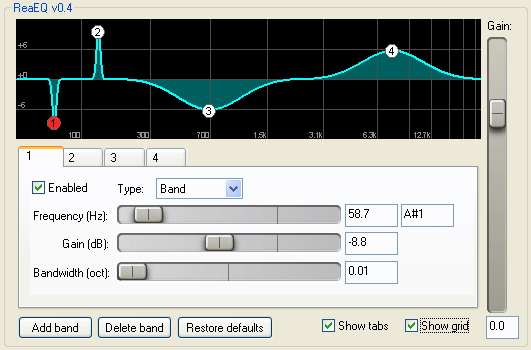The truth is, it’s all filtering.
Parameters
Cutoff or Frequency – Selects the frequency to adjust. This is measured in Hertz
Gain – how much boost or attenuation at the cutoff frequency. This is measured in decibels
Shape or type – this chooses what kind of filter you will be using. The filter shapes are Hi and low pass, band pass, peaking, notch, and shelf.
Quality or Bandwidth – usually just referred to as Q is the shape of the eq curve and how much of the surrounding frequencies will be affected.
What does an equalizer actually do?
An equalizer adjusts the balance of frequencies across the audible range. EQ is an incredibly powerful tool for crafting a mix.
Filter Shapes
A low pass filter also known as high cut filter removes frequencies above the cutoff.
A high pass filter or low cut filter does the opposite, it removes everything below the cutoff.
When you use both these filter types at once it’s called a band pass filter, the top and bottom frequencies are removed.
With these three filter shapes Q effects the steepness of the filter.
A notch filter is the opposite of a band pass filter, it lets all frequencies through except for a narrow notch in the spectrum which is attenuated greatly. The Q effects the width of the notch.
There are two filter shapes that allows you to control how much the frequency will be attenuated.
A low shelf will boost or cut anything below the cutoff, a high shelf gives you boost or cut above the cutoff. You can choose how steep the slope is with the Q control.
A peaking filter is also known as a bell curve, you can boost or cut any frequency with a peak at the cutoff and a slope on either side.
EQ Designs
There are two main types of EQ designs: Graphic and Parametric.
Graphic Equalizers have multiple peaking filters at specific frequency bands and give you a few overlapping frequency bands with adjustable gain. These are most commonly seen on consumer music players, but in professional audio these are very useful for mixing live music.
Parametric Equalizers give you the most flexibility you can choose the shape, cutoff, gain, and quality.
This is the type you will be using when mixing. Nearly all plugin equalizers will be parametric.
EQ Usage Tips
- Use your hi pass filters to remove unnecessary low frequencies from your tracks.
- Use notch filters to remove unwanted noises from a recording.
- Get rid of the frequencies you don’t need before boosting the ones you do, although it may not be your first instinct when eqing, it works a lot better.
- High q values will cause ringing or oscillation when boosted, this is not usually something you want to happen.
- Adjust the EQ so that the level remains constant whether engaged or bypasses, it’s too easy to be fooled by louder being better.

3 comments:
Hi again Jon. Re-commenting. I am a new recording artist intending on mastering recording of music. I am finding that EQ is crucial. Please suggest an easy software tool to EQ my music for commercial application. And I mean Easy! I am thinking of jump in at Pro-Tools, but feel that I would be better off with something more basic and intuitive that won't frustrate me, then take my time to master the ultimate EQ tool & editing software. Regards.
Hello GongMan
There are so many great EQ plugins out there, I often use the one that comes with Reaper (seen in the screenshot above) also available as a VST. The included EQ for Pro Tools is also great but no longer a favorite of mine.
apQualizr is my all-time favorite EQ. http://apulsoft.ch/apqualizr/index.php
The ones I like tend to be the most flexible/powerful. The ones you like may be more simple and intuitive. Many people prefer EQ software without graphics or analyzers, and some like EQs that work like hardware. Having a few different types doesn't hurt.
For SUPER Easy, and FREE try bx_cleansweep. It's just a HPF and LPF but its very useful. A great way to start with filters.http://www.brainworx-music.de/en/plugins/bx_cleansweep_v2
ps. I removed the first comment because I wasn't able to hide your email address. This is to protect you from spam.
Post a Comment